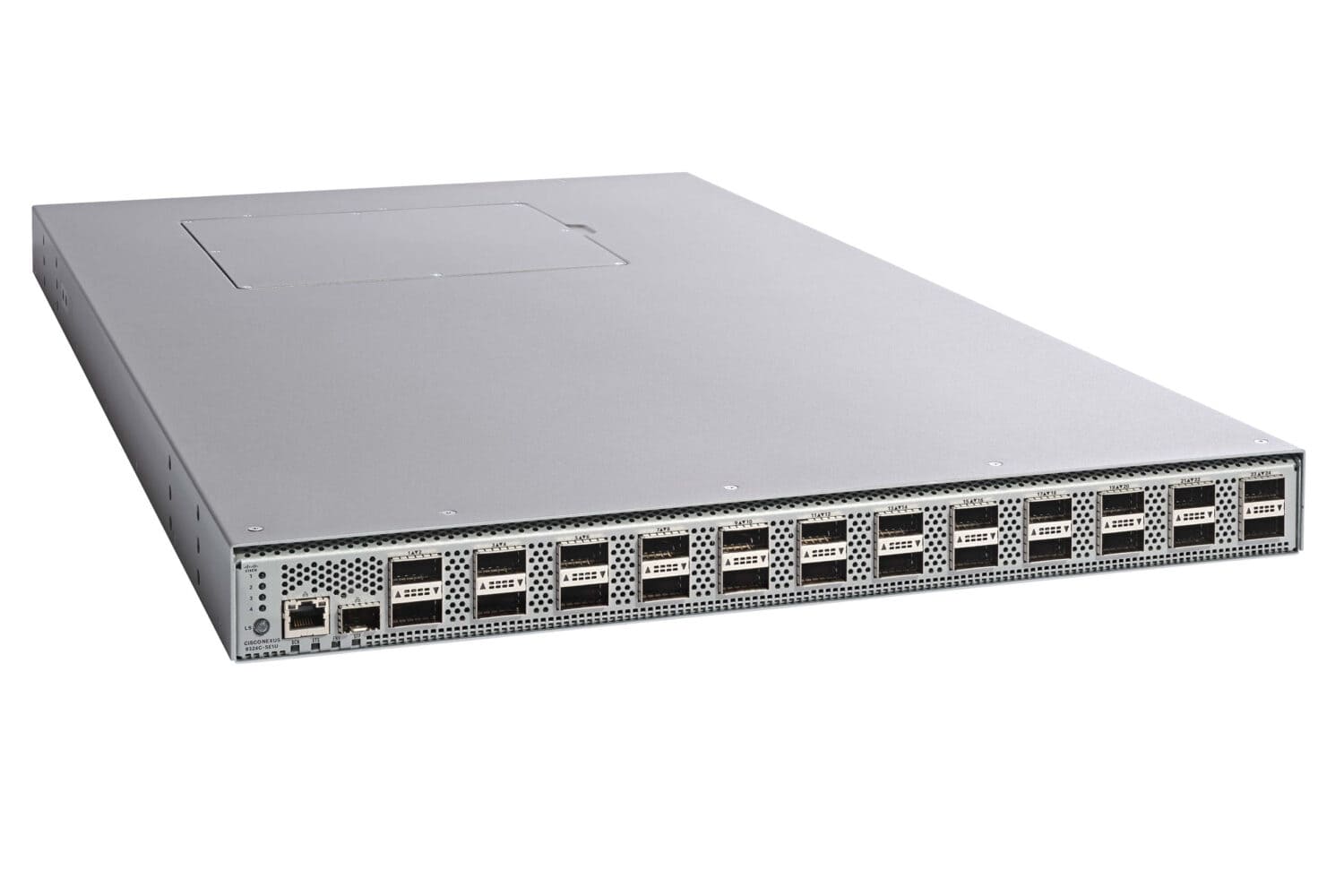At Cisco Live EMEA today, Cisco is announcing many new products and services. There is news around switching, routing, compute en ASIC design. The overarching theme: equipment, networks and data centers are getting substantial updates to cope with the needs and demands of modern workloads and organizations. We list the announcements and what they mean for the market as a whole for you below.
We begin this article with the new line of switches Cisco announced today. These are called N9300 Series Smart Switches. The switches feature Silicon One E100 processors and AMD Pensando DPUs (Data Processing Unit). They come in two variants: one is aimed at linking data centers/zones together, the other is a top-of-rack switch for deployment in data centers. These are the N9324C-SE1U and the N9348Y2C6D-SE1U, respectively. The first has 4 AMD DPUs and should be available in April this year, while the second has 2 and is scheduled for summer. Both, as already indicated, use the same processor, which can deliver throughput of 4.8 Tbps.
New class
We speak briefly with Kevin Wollenweber prior to Cisco Live about these new switches. Wollenweber is SVP and GM of Cisco’s networking and service provider division. After all, these are not just a few new switches. This is really a “new class of devices” for Cisco, in Wollenweber’s words.
What makes this a new class? Cisco has long expressed the ambition that it wants more convergence/integration between networking and security. With switches like these N9300 Series Smart Switches, that should now become possible. In fact, the integrated DPU allows additional services to run directly on the switch. At launch, Cisco Hypershield, the new security architecture Cisco announced last year, will be the first service the company offers in conjunction with the switches.

More fundamentally, the launch of these new high-performance switches means that it will be possible to run more in the network fabric itself. Think of segmentation, for example. These “flatter” networks mean less layering in the infrastructure. In theory, that should yield greater efficiency, higher performance and, of course, better security. There is no longer a need to deploy and manage a huge fleet of SmartNICs spread throughout the network and no need to add DPUs to servers, Wollenweber points out. The DPUs in the switches are powerful enough to take over their tasks.
New to Cisco, not new to the market
The Cisco N9300 Series Smart Switches are definitely a big announcement for Cisco’s lineup. Yet it is not new to the market. For us, at least, upon hearing this news, the HPE Aruba Networking CX10000 Switch Series immediately came to mind. That line of switches als has AMD Pensando DPUs on board.
When we make this observation in our conversation with Wollenweber, he indicates that the N9300 Series Smart Switches are indeed similar. When we then ask why customers should go for Cisco’s implementation, he doesn’t really answer directly. That is, he does not then say “we do this better than Aruba” or anything like that. He does state that only Cisco can also offer a single-vendor integration with Hypershield, which immediately adds a lot of security to the network. For that, other players in the market (read: HPE Aruba Networking) have to find partners. Now, HPE Aruba Networking has been fairly busy lately with innovations in the area of security, and with the acquisition of Juniper Networks (if it goes through, of course) there will be a lot more security coming in, so that could also change relatively quickly. But that aside.
Cisco N9300 Series Smart Switches and VMware NSX
One final comment we make and question we ask in our conversation with Wollenweber is that the N9300 Series Smart Switches can do things that were and are also possible with VMware NSX. After all, that’s also known for offering a (virtualized) network with an emphasis on segmentation and security. And given the developments at Broadcom and VMware in recent years, there will be some organizations looking at alternatives as well. Is this new line of switches aimed as those types of customers too? All Wollenweber would say to this is that this is “a very sharp observation,” while smiling a bit mysteriously. So there seems to be a bit more going on there. There is ambition at Cisco in this area. At least that’s our interpretation.
Agile Services Networking
The introduction of the new line of switches is not all that Cisco has to announce on the networking front today. After all, in addition to data center networks, there are also service provider networks that need to keep up with the times. There is a lot of emphasis on running AI workloads nowadays, which in turn place new demands on the network. The idea is that data created by AI applications is not handled in the same places as data from “traditional” applications. That creates news wants and needs for access, performance, resiliency and data security. It also means that service providers, who provide networks to their customers but also have the data centers that customers use to run the applications, need to address this.
Today, Cisco announces a blueprint of sorts for service providers to address the above issues. This blueprint, or new architecture has been named Agile Services Networking. The idea is that this architecture removes as much complexity as possible and brings together network layers and services. So this also follows the overarching theme of the switches above. For service providers, according to Cisco, there is further benefit in this in that it allows them to deploy services closer to their end users. That should be able to give them more value and thus more revenue for the service providers themselves.
New routers and new optics
Silicon One, not entirely surprisingly, plays an important role in the Agile Services Networking architecture. Specifically, this involves the new Cisco 8000 Series routers for access, edge and metro networks. These feature the new Cisco Silicon One A100 and K100 chips. The models with a K100 processor focus on the so-called distributed edge, the A100-based systems on access networks. The first model will arrive this spring. Other models will follow in the summer.
Putting down powerful and versatile routers is an important part of setting up a modern and resilient service provider network. However, without good connections between different locations, the user experience for customers will still not be good enough. Hence, Cisco has also been working to simplify and improve connectivity. With Cisco Coherent Pluggable Optics, it aims to reduce the use of transponders for common ports by replacing them with new connectors. There is also now a 400G variant that can cover as much as 3,000 kilometers. The first new Coherent Pluggable Optics will be available starting this spring.
Major changes
We have criticized Cisco at times in recent years about how there seemed to be very little focus on the network anymore. It was all about security and collaboration, but network innovation seemed a bit out of it. While Silicon One was announced in 2019 with much fanfare, even that did not quite deliver what it promised as far as we were concerned. Today, however, Cisco is sending a very clear signal that it is definitely not done in this area. Silicon One plays a central role in the new story, also showing more and more clearly how Cisco envisions the convergence between security and the network, for example.
Of course, this cannot be seen in isolation from other developments in the networking market. Just last year, HPE Aruba Networking and Juniper Networks jointly expressed their ambition to oust Cisco from first place. Quite apart from whether that can continue at all with the lawsuit now pending from the U.S. government, that was a rather bold statement anyway. After all, Cisco is not a little bit bigger, but a whole lot bigger, even if the two merge.
However, should there still be any misunderstanding as to whether Cisco is ready for battle, that is no longer the case after today. Mind you, for the market leader, Cisco is late with the N9300 Series Smart Switches with integrated DPU. After all, HPE Aruba Networking was there earlier with the CX10000 Series. Now, however, Cisco is going to crank up its huge sales engines. Then things generally go pretty fast. It’s going to be interesting times again in the networking world anyway, that much is certain.
